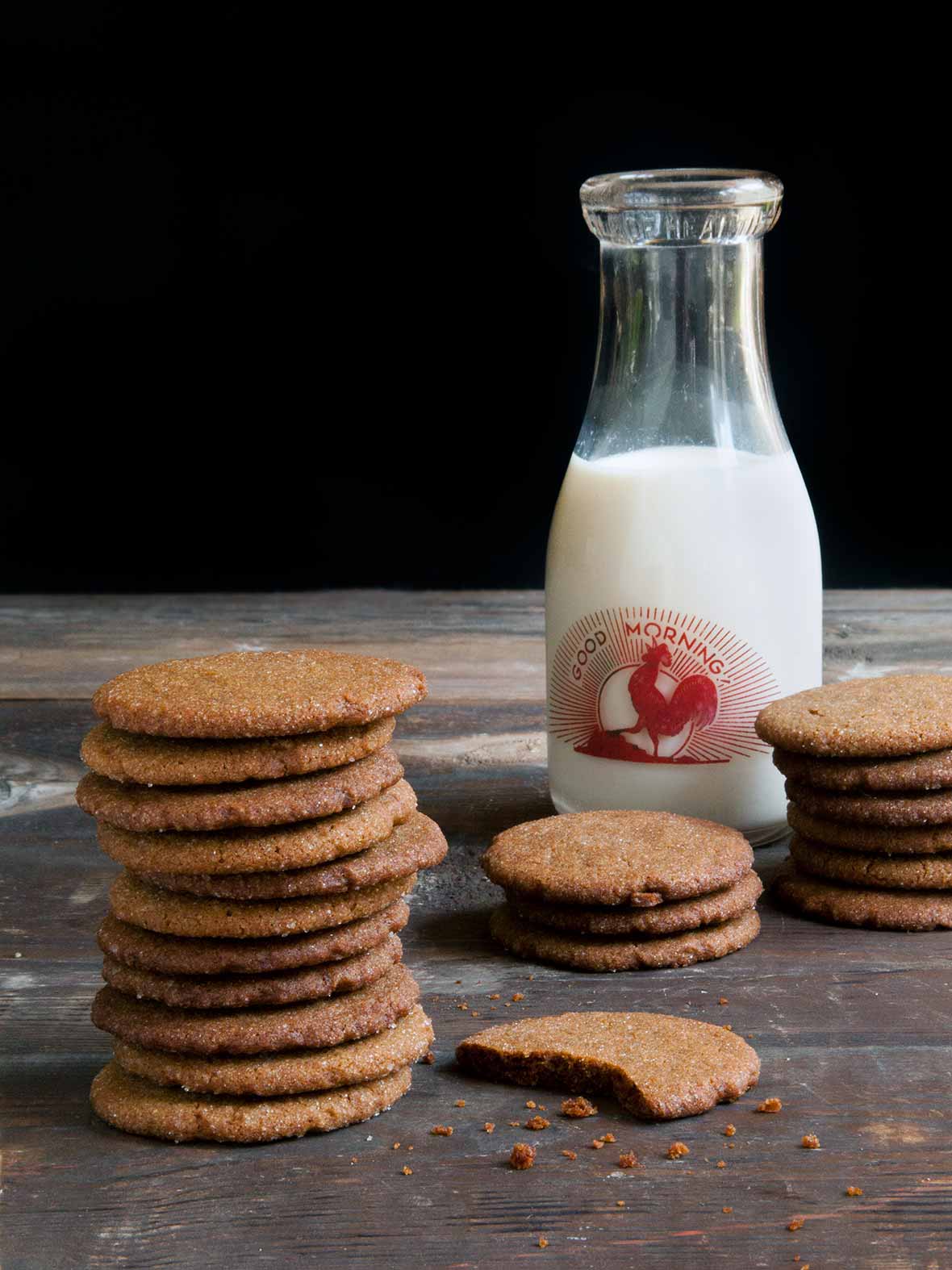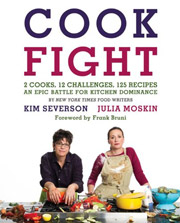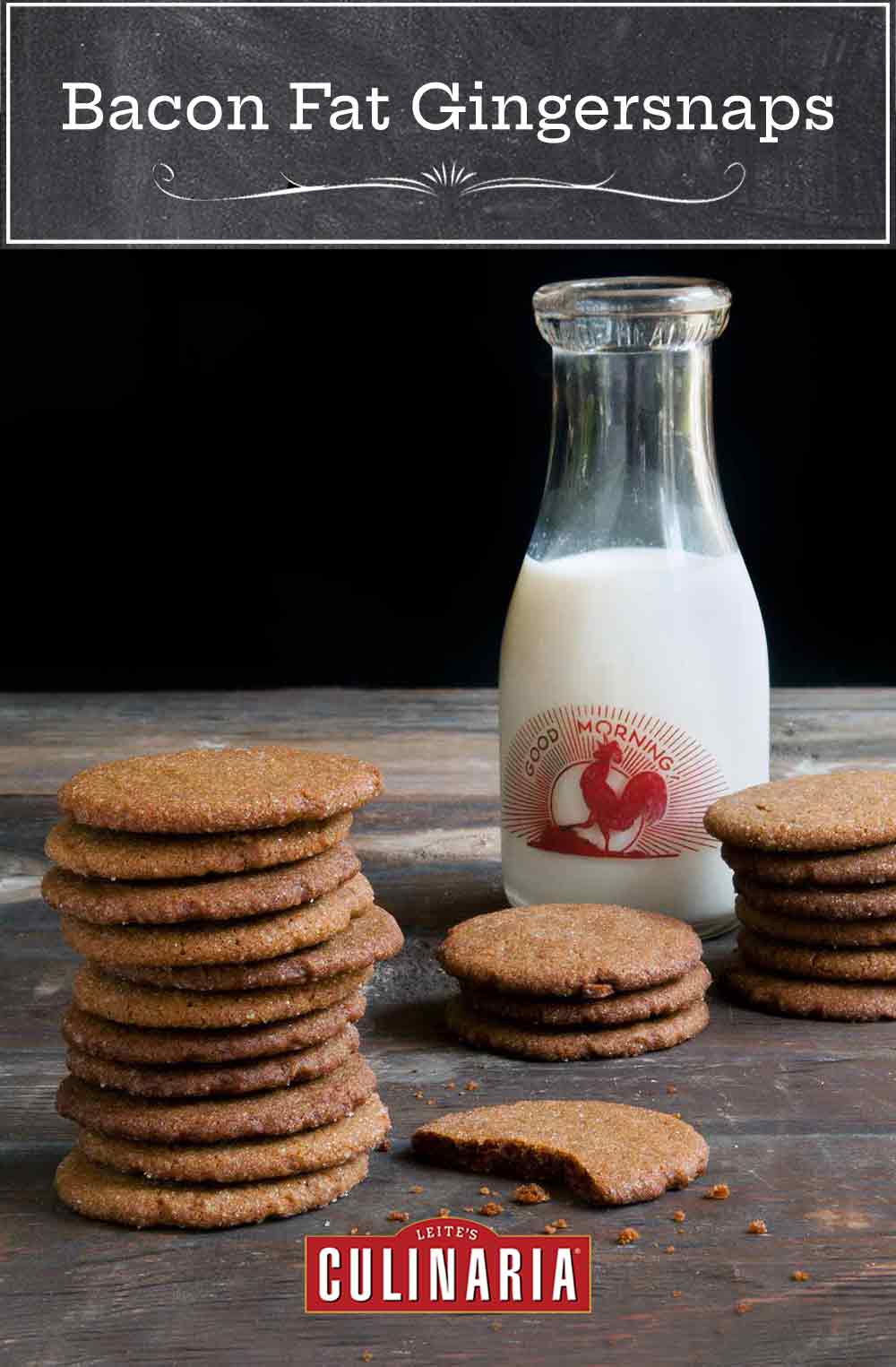
Forgive me while I reach for the nearest credenza because these bacon fat gingersnaps have caused me to go weak in the knees. (Ok, so maybe I exaggerate, but they are freakingly damn good.)
Between us, I wasn’t in the mood to bake that afternoon. It was a gorgeous day, and the last thing I wanted to do was heat up the kitchen. But at the urgings of The One, I did. Smart move.
The dough literally comes together in minutes—that is, if you have bacon fat on hand, which I didn’t.
In my case, it took an additional 20 minutes or so to fry up enough bacon to get the requisite 3/4 cup of bacon fat. (That was just over 1 pound of bacon. What a hardship to have to eat bacon. The things I do for your sake, dear readers.)
I refrigerated the dough for 12 hours just because I was up to my eyeballs in Friday errands. Saturday afternoon, I rolled and dipped the cookies. I flattened them with the bottom of a drinking glass as I wanted the cookies to have a smooth rather than crinkled top.
When I pulled them out of the oven, The One was just coming up form the basement. “It smells like fall!” he shouted and headed for the rack of cooling cookies. He didn’t say anything. Well, he couldn’t say anything (his mouth was so full) until after his third cookie. Then he managed to utter, “Love ’em!”
Sadly, I only had a nibble. What a bitch of a time to cut sugar from my diet.
A few tips that I think may help when you make these marvelous gems:
- Choose your bacon carefully. Some cheapo store brands are loaded with salt, which will make the cookies inedible. I used what I believe is an easily available brand for most of you: COSTCO’s Kirkland bacon.
- Taste the bacon fat before adding it to the dough. I know, I know, gross. But hear me out: If the fat is really salty, then add less than the full amount of salt to the recipe. Or add none. My bacon fat was just mildly salty so I added just 1 teaspoon salt instead of the full 1 1/2 teaspoons.
- My cookies had a mildly smoky flavor. If you want a more pronounced smokiness, make sure you buy heavily smoked bacon. Or, ahem, make your own bacon.
Chocolate Bacon Fat Gingersnaps Variation
To make bacon fat gingersnaps gilded with chocolate chunks and crystallized ginger, follow the recipe above and stir in 2/3 cup chopped chocolate or mini chocolate chips and 1/2 cup finely chopped crystallized ginger. (Okay, fine, you can add more or less than these amounts to suit your taste.) We found that these add-ins tend to work better with slightly larger cookies (1 ounces or 28 grams). If making the larger cookies, you’ll need to bake them a little longer, figure 12 to 14 minutes.
VIDEO: How to Make Bacon-y Gingersnaps

Bacon Fat Gingersnaps
Ingredients
- 3/4 cup bacon drippings (from 1 to 2 pounds bacon), at room temperature
- 1 cup granulated sugar, plus more for the work surface
- 1/4 cup molasses (not blackstrap) or cane syrup
- 1 large egg
- 2 cups all-purpose flour
- 1/2 to 1 1/2 teaspoons kosher salt (See “David Says” below)
- 2 teaspoons baking soda
- 2 teaspoons ground ginger
- 1/2 teaspoon ground cloves
- 1/2 teaspoon ground cinnamon
Instructions
Make the dough
- Toss all of the ingredients in a food processor and pulse until the ingredients clump together and a dough forms. Wrap the dough tightly in plastic wrap and refrigerate for at least a few hours and up to 2 days.
- Preheat the oven to 350°F (176°C). Line 2 baking sheets with parchment paper.
Shape and bake the cookies
- Place about 1/4 cup sugar in a shallow bowl. Break off 1-tablespoon chunks of cookie dough (about 17 g) and roll them into balls. Drop them into the sugar, roll to completely coat the dough in sugar, and place them on the baking sheets, spacing them about 2 inches apart. If you prefer crisp cookies, gently flatten the dough; if you prefer chewy cookies, don’t mess with the dough any more.
- Bake the cookies for 10 to 12 minutes, until dark brown. Let cool on the baking sheets for a few minutes and then transfer them to a wire rack to cool completely. (We usually include storage advice here, but honestly, they didn’t last long enough for us to be able to say how well they keep.)
Notes
Chocolate Bacon Fat-Crystallized Gingersnaps Variation
To make bacon fat gingersnaps gilded with chocolate chunks and crystallized ginger, follow the recipe above and stir in 2/3 cup chopped chocolate or mini chocolate chips and 1/2 cup finely chopped crystallized ginger. (Okay, fine, you can add more or less than these amounts to suit your taste.) I found that these add-ins tend to work better with slightly larger cookies (1 ounces or 28 grams). If making the larger cookies, you’ll need to bake them a little longer, figure 12 to 14 minutes.
Nutrition
Nutrition information is automatically calculated, so should only be used as an approximation.
Recipe Testers’ Reviews
I admit I’m not a gingersnap kind of girl. For me, there are better cookies just waiting to be eaten. Until now. These bacon fat gingersnaps were some of the best damn cookies I’ve ever had, gingersnap or not. Don’t let the bacon drippings scare you; they just add a slightly smoky and salty bite to an incredibly luscious cookie. I took them to a friend’s house tonight. His response, after he ate one bite, was “Good God, these are the best things I’ve ever eaten.” In light of my new love of gingersnaps, I’ve become a bacon-fat hoarder. I never know when the urge might strike. Soo-ee, here pig, pig, pig.
These bacon fat gingersnaps are some of the best snaps we’ve ever enjoyed. They’re easy to make, although I’d add the dry ingredients to the food processor before adding the bacon fat and molasses. It’s fun to ask your friends what they think the secret ingredient is in the cookie. They’ll be amazed, then ask for another cookie. Plus, your dog will love you more than ever.
I’ve never been much of a baker, but these bacon fat gingersnaps are extremely easy to make and have that gingery “bite” I love. Amazingly, none of us could taste the bacon fat, yet it worked amazingly well. I did use all-purpose gluten-free flour but I didn’t change any of the measurements in the recipe. They spread quite a bit, yet they were still a tad gooey in the middle. Yummm! If I had to choose between the aroma during baking and the taste while devouring them, I’m not certain which was better; all I know is that the cookies didn’t last long in this household.













I made the bacon cookie recipe from the mid 1990’s Martha Stewart Living issue for my Christmas cookie assortment gift package. I made the mistake of telling my friend of the bacon fat, and she promptly regifted to her unsuspecting office mates. She said they loved them. It was also the last time I made her cookies. It was a lovely recipe and a great story of the resourcefulness of those who lived through World War II. Mele Kalikimaka!
Ann, of course you never made her cookies again after that! Thanks for sharing, do let us know if you give this recipe a whirl, and yes, Mele Kalikimaka!
Renee, aka Bacon Fat Sister, how lovely to hear about your German grandmother and her coffee can of bacon fat/drippings. I, too, grew up in a similar household–my mother and her three sisters were two generations removed from French-German Alsace, a family that had migrated to The Southern Heartland of Louisville, KY. I think I may have inherited several cans of bacon fat–at any rate, I’ve never been without one. Can’t make cornbread without bacon fat! Can’t make my mother’s mashed potato, onions, celery, and bread turkey dressing without bacon fat! The list goes on…and on. But now here’s a question: for years I used an empty coffee can for the drippings (which, by the way, seem to have a refrigerated shelf life of eternity) until, of course, the good coffee revolution took hold, and bags became the container of choice. I now use empty nut tins (which have a plastic lid), although they lack the sturdiness of the old coffee cans. Am curious: what do you use? And–listen up artisan food makers and butchers: Is packaged bacon fat a possible $$$ item or what?
Hah! Sister Suzanne, lovely to make your acquaintance, I already like you quite a lot! Love your bacon fat heritage, just love it. As for me, I use a glass Anchor Hocking container with a lid. I just found it online, they must’ve discontinued this line because when I stocked up on these they were a fraction of the current price. The lid doesn’t seal around the edges, but if I have an extra large stash of bacon drippings that I intend to tuck in the fridge for a while, I just place a sheet of plastic wrap between the container and the lid to seal out the air and aromas. What do the rest of you use to keep your stash safe? And Suzanne, brilliant call on the artisanal bacon drippings. I’ve visions of heritage bacon fat dancing in my head….
Thanks, Renee! Terrific idea re heavy glass (or Pyrex, a personal fav)–and unlike the old coffee can, there’s the bonus of seeing exactly how much of the precious stuff you have. I’ll search around for something low in dollars and high on capacity. As for our new fat friendship, I’ve been a secret admirer of yours for as long as you’ve been at LC. Your wit and deep culinary knowledge and expertise are rare indeed in an era of “Everyone’s a Food Blogger–No Skills Needed.” Best to David, by the way. The two of you have created The Best of The Food Web, hands down, no contest.
Sister Suzanne, I am at a blushing loss for words. Am quite grateful for your generous and gracious words—all of them. Bow (or ought it be a curtsy?) of gratitude.
I use an empty relish jar for my bacon fat. A pickle jar would work if you collect more at one time (mine has about 1 cup capacity, I think but it never gets empty).
I know this is an old comment, but thought I’d share for others.
Thanks, Melissa.
I can’t speak for the Portuguese, but my frugal great-grandmother, a life-long Vermonter, routinely saved her bacon drippings – and used them as the secret ingredient in her famous molasses cookies. Modern maybe – what is old is new again!
Milk and Cookies, you have to try this recipe- they are amazing!